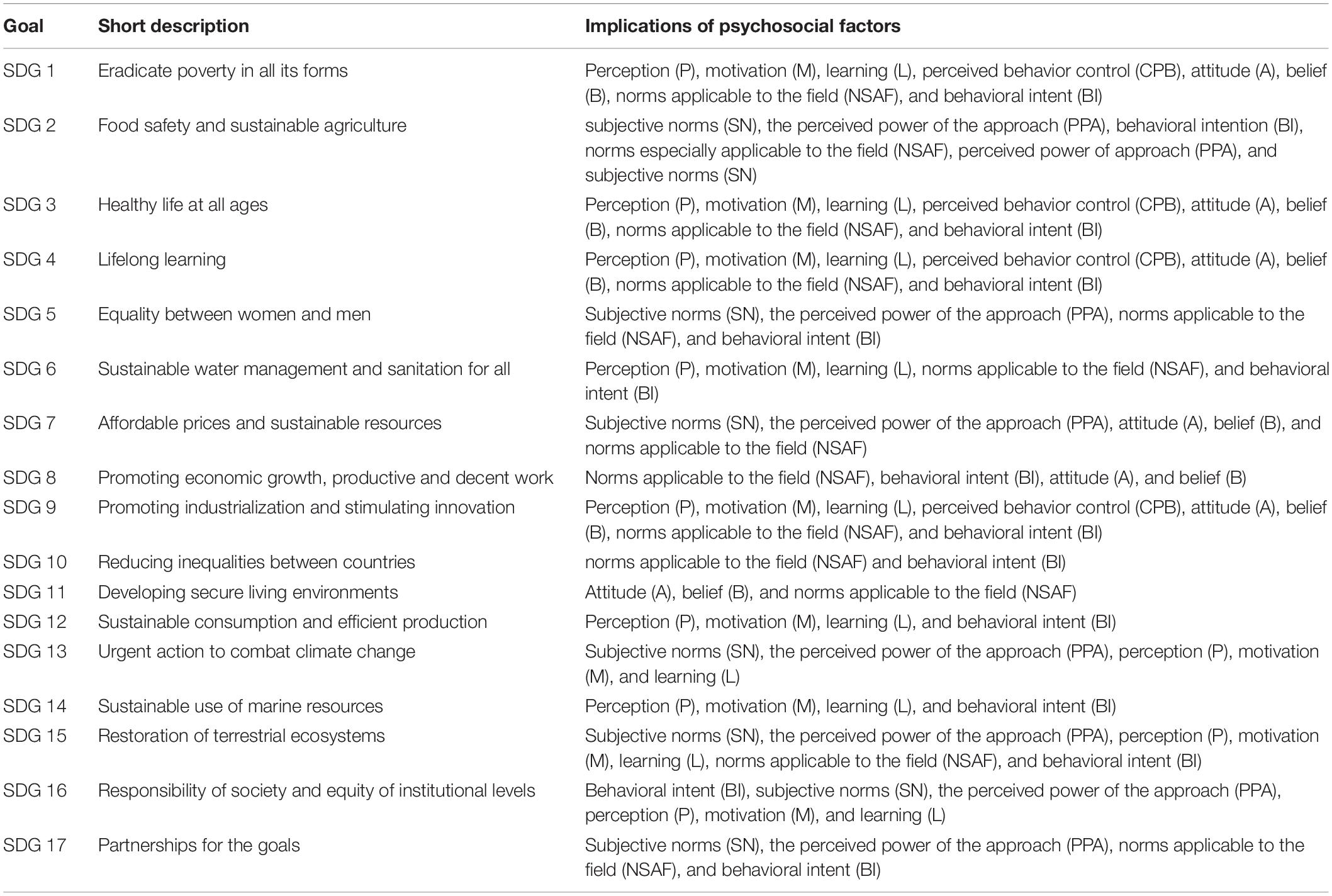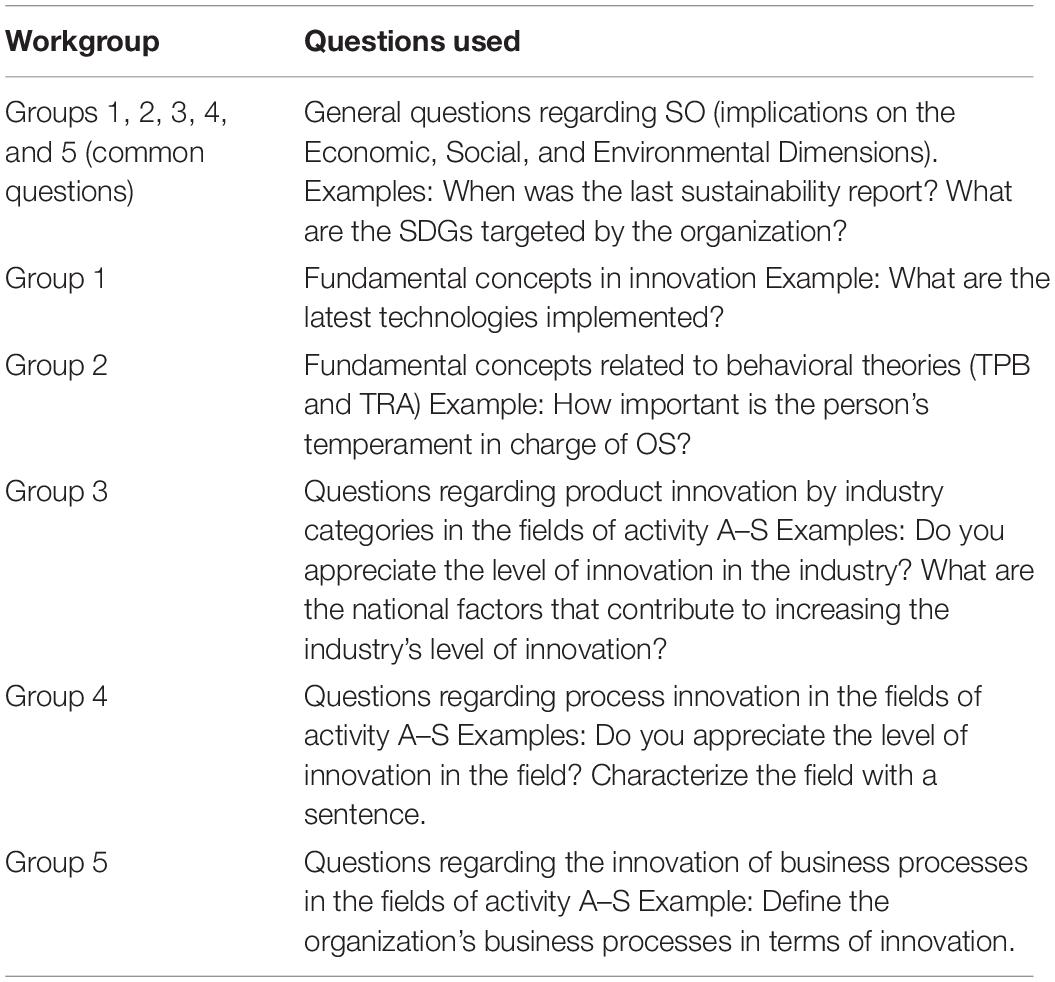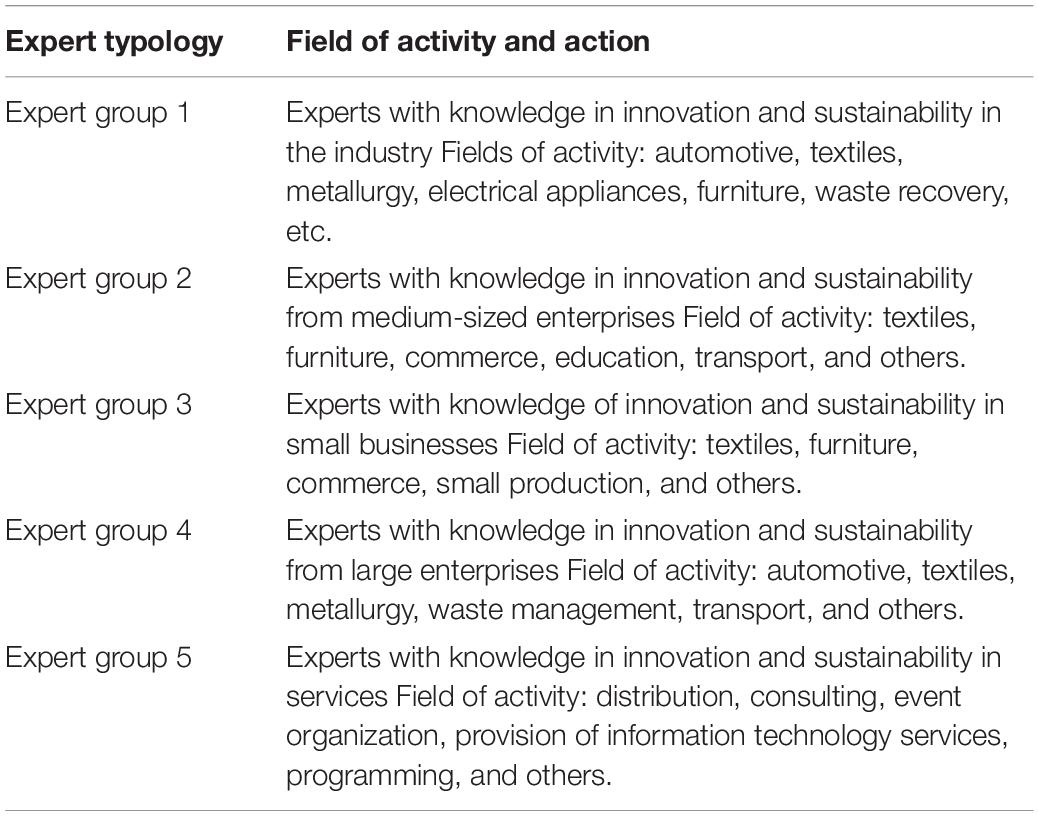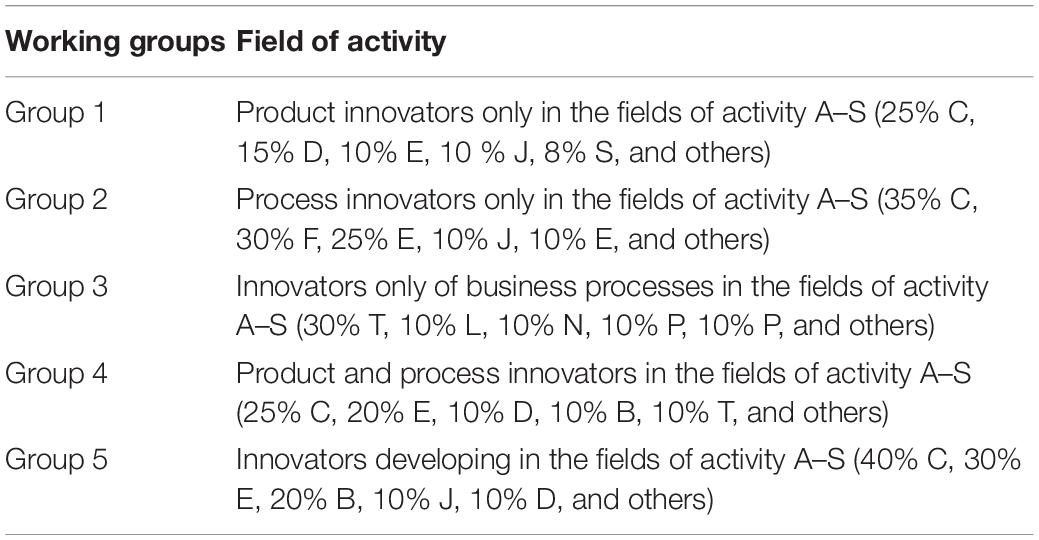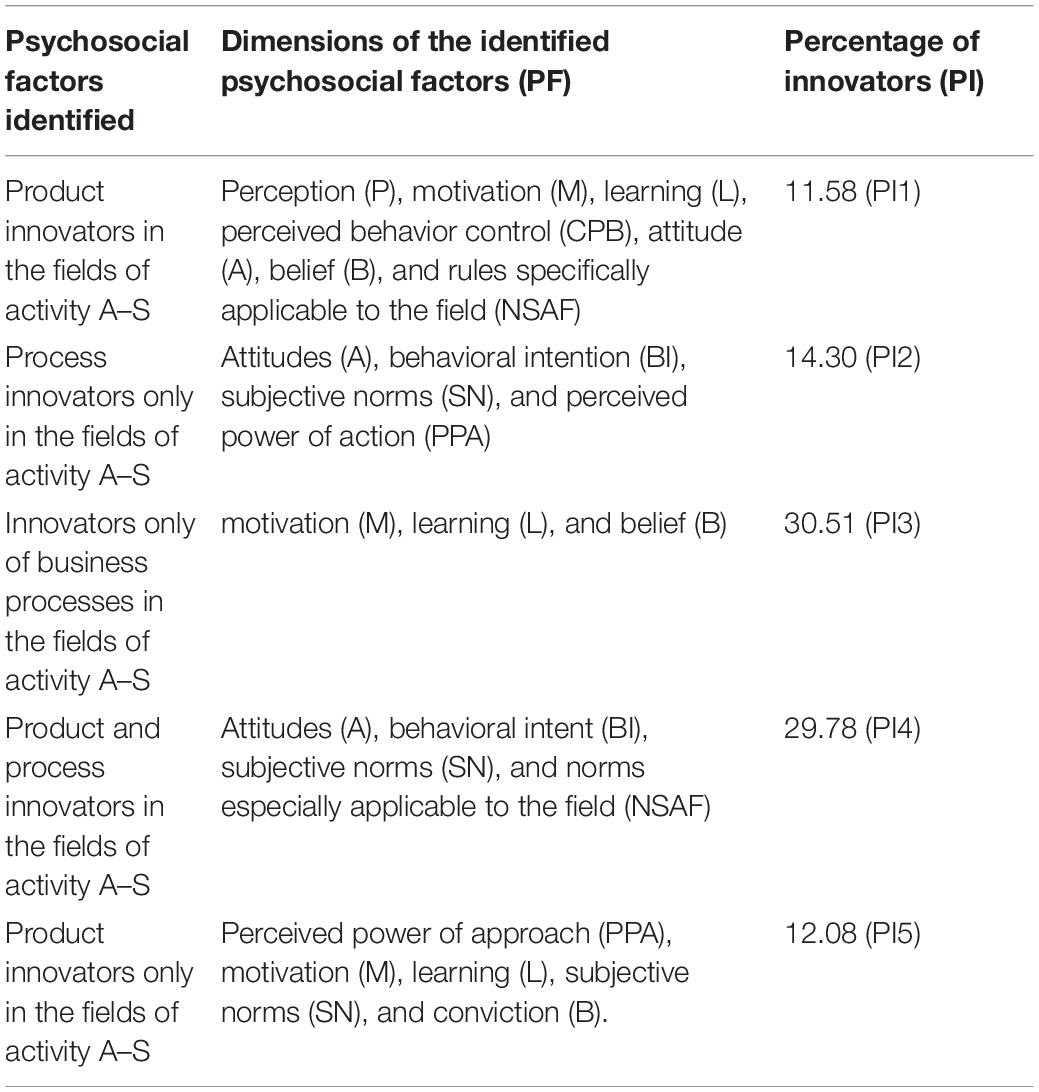- 1Department of Automation and Applied Informatics, Faculty of Automation and Computers, Politehnica University of Timisoara, Timisoara, Romania
- 2College of Economics and Management, Southwest University, Chongqing, China
- 3Department of Management, Faculty of Management in Production and Transportation, Politehnica University of Timisoara, Timisoara, Romania
- 4Research Center in Engineering and Management, Timisoara, Romania
- 5Hailey College of Commerce, University of the Punjab, Lahore, Pakistan
Involvement in sustainable development is a voluntary activity. Organizations apply the principles of sustainable development only when they identify several benefits. These benefits are identified, especially with the financial ones. The involvement of organizations in sustainable organizations has different intensity levels. These intensity levels are influenced by psychosocial factors (PF), attitudes toward organizational risks, and organizational and urban policies. The present paper identifies the key psychological factors involved in applying organizational sustainability principles within organizations. For this research, five groups were created for in-depth interviews with key people from Romania’s innovative companies. To identify the importance of the framework analysis factors, the Delphi method was used, in which 20 experts from different fields of activity were involved. Following the rounds involved in the Delphi method, the ranking of PF on four levels of importance was accepted, based on planned behavior and reasoned action theory. These levels were correlated with the intensity levels of involvement in sustainable development. The entire market study was conducted during COVID-19, which significantly impacted specific directions. As a result, it could be observed that motivation, learning attitude, behavior, and intention to take precedence are essential in the organizational sustainability approach.
Introduction
Sustainability means that a company can secure its long-term resources, anticipate its future needs, and use resources efficiently and fairly in organizational activities. This is a reference definition, developed in 1987 by Norwegian Prime Minister Gro Harlem Brundtland in the report entitled “Our Common Future,” prepared by the United Nations World Commission on Environment and Development. Sustainability does not only mean ecology, it also means achieving a balance between the three responsibilities: economic, social, and environmental. These responsibilities are embedded in most existing definitions in the literature, where there are several concerns for social equity and economic development (Horn et al., 2012; Noone et al., 2018; Pislaru et al., 2019).
Involvement in sustainable development differs from one company to another. Some of the companies are heavily involved, with several benefits. Other companies get involved for specific criteria they want to achieve (requiring employees to report their sustainability or have an adequate environmental footprint). It can be seen that in the manufacturing industry (Labuschagne et al., 2005; Jayal et al., 2010; Hesselbach and Herrmann, 2011; Mani et al., 2014; Ford and Despeisse, 2016; Kayikci, 2018), the implications are numerous. Over the years, this industry has shown an increasing evolution from involvement. The construction sector (Naik, 2008; Abidin, 2009; Marhani et al., 2012; Yılmaz and Bakı, 2015; Molavi and Barral, 2016; Kamali and Hewage, 2017) has many implications. Within this sector, the implications refer to buildings’ energy efficiency and the use of adequate construction materials. The electricity and heat sector, gas, hot water, and air conditioning are making considerable progress in sustainability principles (Oparaocha and Dutta, 2011; Sinclair et al., 2015; Dincer and Acar, 2017; Kveselis et al., 2017). Here, steps are being taken to reduce greenhouse gasses generated in the atmosphere. They began to use innovative technologies that consider consumer-dependent factors (Blevis, 2007; Barquet et al., 2016; Lal, 2016; Arfini et al., 2019). Studies conducted in the machine-building industry have highlighted the need to investigate psychosocial factors (PF) to increase the level of involvement in OS. Factors are mentioned as motivation and attitude (Cioca et al., 2015). The transport sector is also making progress due to new technologies used in vehicle manufacturing (Richardson, 2005; Steg and Gifford, 2005; Anderton, 2010; Yigitcanlar and Dur, 2010). Pollution norms contribute to reducing the level of greenhouse gasses and fuel efficiency. In this way, combined with driver-dependent factors, efficient use of resources in the field of transport (Steg and Gifford, 2005; Anderton, 2010; Cruijssen, 2020). It can be seen that the implications of organizations in different fields are numerous (Al-Mulali and Ozturk, 2015; Apergis and Ozturk, 2015; Farhani and Ozturk, 2015; Ozturk, 2017). The involvement of organizations in this voluntary approach depends on several factors. These factors include psychological factors, social factors, economic factors, technological factors, and other factors. Psychological factors are considered some of the most important, especially when it comes to the entry barrier. Among the social factors that contribute to the success of adopting approaches for sustainability are perception, motivation, learning, attitudes, beliefs, self-efficacy, culture, and others (Abdullah et al., 2017, 2018; Sarfraz et al., 2018a,b). Being a voluntary approach, the social factors’ approach presents a necessity in successfully implementing the principles of sustainability (Bocken et al., 2014; Eccles et al., 2014; Adloff, 2019).
The benefits involved in the organizational sustainability are diverse and multiple. First of all, there can be an improvement in financial results. These benefits are most attractive to organizations. Also, the following can be achieved: efficiency of processes and activities, increasing the level of innovation, reducing the carbon footprint and water, waste management, growing capacity of globalization, improving employee skills, strengthening work teams, aligning with global requirements, attracting new business partners, identifying new organizational opportunities, fulfilling an international vision, improving the image, and others (Apergis and Ozturk, 2015; Ivascu, 2020).
Several studies emphasize the need to identify PF. Identifying these factors can contribute to an accentuation of their treatment to intensify the involvement of organizations in organizational sustainability (Ivascu, 2020). There are several studies on organizational sustainability in Romania, but studies on PF are very few. These existing studies target the industry with a few limitations. Therefore, we have identified a need for a national study to help organizations identify and improve their PF for OS. In this variant, the organizational implications in sustainability can be intensified, and the organizations can increase their level of innovation (Cioca et al., 2015; Ivascu, 2020).
This research aims to identify PF at the level of organizations in Romania and improve the level of intensity of organizations for involvement in organizational sustainability. These intensity levels are influenced by PF, attitudes toward organizational risks, and organizational and urban policies. This study can be customized for specific activity fields or branches of activity. This study can be customized for specific activity fields or branches of activity and represents a pillar in intensifying the levels of the organization. Based on a transdisciplinary approach, the applied methodology allows the generation of a nuanced interpretation of problematic implications. It addresses the gaps in psychology that apply to sustainable organizational development. It enhances organizations’ innovation. In-depth interviews were analyzed with framework analyses. The paper begins with the presentation of the essential research in sustainability. It continues with the importance of innovation and involvement in OS, matrix presentation of factors identified in interviews, and developing the logic of intensity levels developed due to applying the Delphi method. Finally, the main elements found are presented. The conclusions refer to the practical and academic contributions within this organizational sustainability field.
Literature Review
Involvement in sustainability involves innovative approaches that develop several benefits for the organization. One cannot discuss sustainability without innovation and vice versa. It is a two-way relationship that supports PF for organizational involvement. Given this relationship, the chapter is structured on the following directions: the presentation of organizational sustainability, the importance of innovation for sustainability, and organizational theories applicable in companies (Linnenluecke and Griffiths, 2010; Liu et al., 2015).
Sustainable Organization
Sustainability and sustainable development as concepts have gone through different development stages since their introduction. The historical development of the concept has taken place at various conferences, within organizations and institutions, which are currently concerned with implementing the principles, goals, and objectives of sustainable development. The concept of sustainable development has known various criticisms and interpretations over time, being accepted in various activity fields (Sadiq et al., 2020). In its development, the concept has adapted to a complex global environment’s contemporary requirements. Still, the basic principles and objectives, as well as the problems of their implementation, have remained almost unchanged. However, some goals have been updated, and new goals have been set since 2015. These goals are united in the 2030 Agenda, which outlines the challenges that humanity must meet for sustainable development, but also to survive on the planet (Choong and McKay, 2014; Erdmann Hilty et al., 2004; Ma et al., 2014; Honda, 2020).
In the 18th century, economic theorists, such as Adam Smith, pointed out organizational development problems. In the 19th century, Karl Marx and the classical economists Malthus, Ricardo, and Mill argued for certain sustainable development elements. In contrast, economic theory Neoclassical stressed the importance of pure air, water, and renewable resources (fossil fuels, ores), as well as the need for government intervention in extraordinary cases. Previous periods have dominated economic doctrine dominance, emphasizing human capital as a natural resource pilot (Smith et al., 2010; Tainter, 2011; Strathern and Stewart, 2018).
The term “sustainable development” was initially introduced in forestry and included afforestation measures for interconnected forests, which should not undermine forests’ biological renewal. This term was first mentioned in the International Union for Conservation of Nature (IUCN) Strategy for Nature and Natural Resources (IUCN), published [International Union for Conservation of Nature (IUCN) (2020)].
Sustainable development actions target 17 objectives (SDGs) and 169 targets (Lim et al., 2016; Pradhan et al., 2017; Schroeder et al., 2019). The companies partially aim at these objectives included in the 2030 Agenda. By evaluating the 17 objectives and the PF that influence the organizational implications, the authors perform an analysis presented in Table 1.
The Importance of Innovation for Organizational Sustainability
Innovation has a vital role in the current dynamics of the business environment. Innovative organizations aim at a series of objectives and targets of sustainable development. At the level of Romania, innovative enterprises’ situation is presented in Table 2 (National Institute of Statistics, 2020). It can be seen that the manufacturing industry and services present innovative enterprises for the analyzed period.

Table 2. The situation of innovative enterprises in Romania (National Institute of Statistics, 2020).
From the perspective of innovators in the analyzed period 2015–2019, in Romania, the situation is presented in Table 3. Product and process innovators are among the first to innovate. At the same time, innovative business processes innovate and are in a favorable position. The number of innovators has increased to 4,198 in 2020 (National Institute of Statistics, 2020).
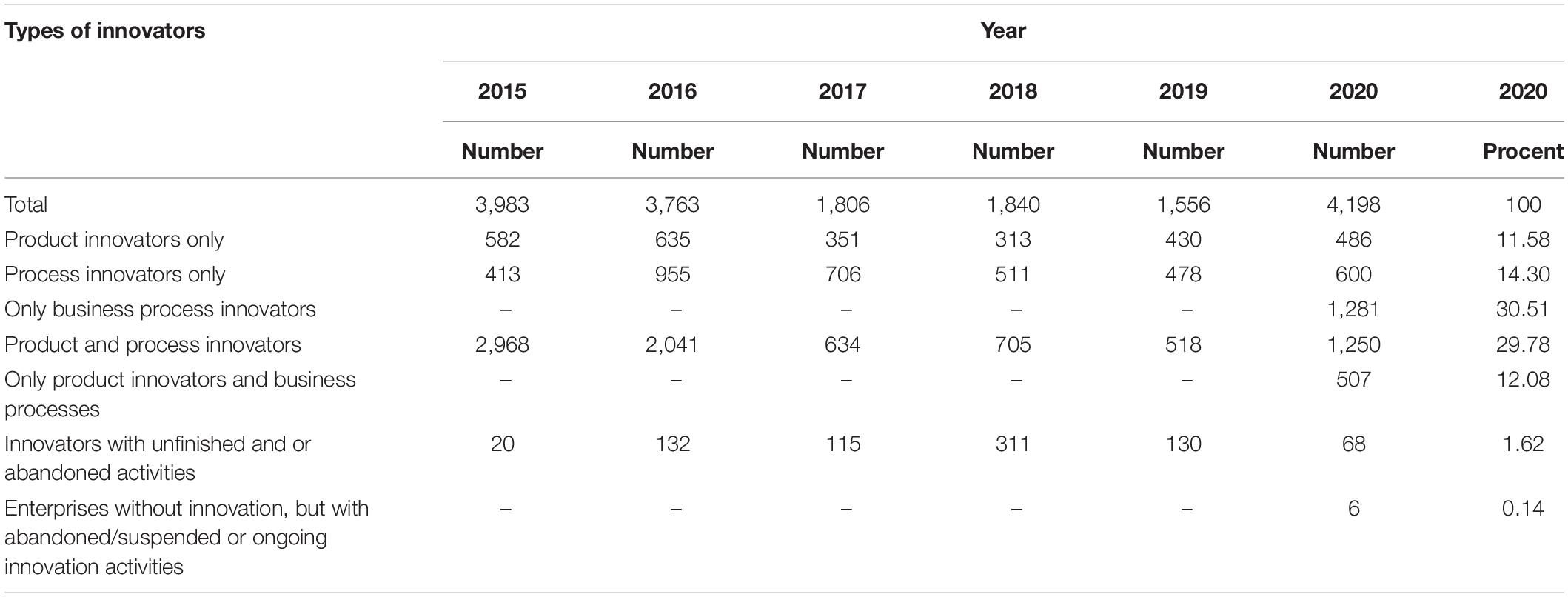
Table 3. Types of innovators in Romania (National Institute of Statistics, 2020).
From the perspective of size, the situation is presented in Table 4. It can be seen that small enterprises register the most crucial level of innovation. Medium-sized enterprises follow them. The industry has an essential impact on innovation’s perspective (National Institute of Statistics, 2020).

Table 4. The situation of innovative enterprises by size classes (National Institute of Statistics, 2020).
Table 5 presents the share of enterprises with organizational innovation in the main activity fields. The manufacturing industry holds a vital percentage, followed by the production and supply of electricity and heat, gas, hot water, air conditioning, and services. The whole situation is presented below (National Institute of Statistics, 2020).

Table 5. Percentage of enterprises with organizational innovation by activities (National Institute of Statistics, 2020).
Organizational Theories Applicable to the Present Research
The theory of Reasoned Action (TRA or ToRA) was developed by Martin Fishbein and Icek Ajzen, an improvement in information integration theory (Fishbein and Ajzen, 1975, 2010; Hill et al., 1977), a cognitive theory that presents a conceptual framework for understanding human behavior in different situations. This theory helps explain individuals’ behavior and involvement in various activities or decision-making situations. Behavioral intention (BI) is created or caused by two factors: attitudes (what is expected to be done and motivation) and subjective norms (SN) (strengthening the normative faith and persuasive objectives) (Madden et al., 1992; Lada et al., 2009; Trafimow, 2009; Rossmann, 2011; Hale et al., 2002). It is an extension of TRA, and the main component of this model is behavioral intent. Individual attitudes and subjective risk assessment influence these BIs. TPB consists of six constructions: attitudes, BI, SN, social norms, perceived power, and perceived behavioral control (Ajzen, 1985, 1991, 2012; Rizzo and Columna, 2020).
Methodology
The research methodology is qualitative and transdisciplinary based on the experts’ empirical experience in sustainability. Below are the details of each step applied in the research presented. The entire research was carried out during (and has faced the impact of) the COVID-19 period, March–November 2020, when most of the organizational activities were carried out through telework. The companies involved in the present research are in categories A–S (presented in Appendix 1). The methods selected for this research have several advantages based on research. During this period of applying this study’s methods, a large part of the subjects involved in the study worked in telework. For each method used, the advantages are presented.
In-Depth Interviews
This research method is a qualitative one and involves direct contact with each participant. In-depth interviews are used to collect data because they have several advantages, especially during the COVID-19 period. These advantages include the following: sensitive topics can record complex and clear answers, subjects will feel comfortable and answer all questions, key topics can be researched and can be returned to at any time, it is a superior quality for sampling, the number of respondents does not have to be very large to obtain remarkable and relevant results, there is no possibility of pressure from participants, interviewers can monitor the tone and words used by participants, and the degree of focus on the topics is higher (Guest et al., 2006; Longhurst, 2009; Campbell et al., 2013; Adams and Cox, 2016).
To conclude this initial research, five working groups were set up. In the five working groups, 150 interviewees from Romanian organizations apply sustainability principles in their operations. An expert in organizational sustainability interviewed each working group. This helped to avoid the loss of essential data. Among the advantages of this method are the following: collecting a large amount of data, the information obtained is qualified and conclusive, and coordinating the interviews in the intended direction. For in-depth interviews, 10 common questions and five different questions were established for each working group. The structure of these questions is presented in Table 6. The five different questions were established by the experts used in the application of the Delphi method. These questions were developed according to the companies’ particularities of activity that constitute each working group.
Delphi Method
The Delphi method involves a structured communication method that applies to a group of experts through the synchronous communication method. These experts evaluate the reports generated in several rounds of decisions until all experts agree with the variant generated. The method generates a final report of the decisions accepted by all experts. The Delphi method has several advantages, given in the present study. These advantages include the following: participants can be found anywhere in the world, a quick consensus of those discussed is obtained, it covers a wide range of expertise, avoids long interpretations and discussions, the predicted questions are specific and have predetermined answers, and you get a final report agreed by all experts during the study (Linstone and Turoff et al., 1976; Gordon and Pease, 2006; Botterill and Platenkamp, 2014; Chalmers and Armour, 2019; Humphrey-Murto et al., 2020). Find involved experts who consider that the final report is an adequate one and contains vital information for the targeted field. In the present research, 20 experts from the critical sustainability and innovation fields were involved. The expertise and their fields of action are presented in Table 7. The division of experts into groups was made according to the enterprises’ size involved in innovation.
The scheme of applying the Delphi method is presented in Figure 1. It can be seen in the proposed logical scheme that five rounds of in-depth discussions were held with experts in the field of SD and innovation to assess the levels of importance of PF identified and to achieve hierarchy and their correlation.
Market Research and the Investigated Sample
The market research was conducted during COVID-19, March–November 2020. Given this period’s specifics, the study was conducted by the asynchronous method using online video conferencing platforms.
The investigated sample consisted of 150 representatives of companies with solid knowledge of innovation and sustainable development. The sampling was randomly applied to a group of 500 possible participants (organizations identified participants). The companies’ fields of activity are in the fields of A–S (presented in Appendix 1). The five working groups were formed by random sampling, presented in Table 8. In each group, 30 individuals were involved with solid knowledge in organizational sustainability. The five groups’ structure emphasizes that Romania’s essential fields of activity have been covered. The working groups’ structure was established based on the types of innovators evaluated for 2015–2019 and following the fields of activity presented in Appendix 1. These classifications are provided by the Romanian legislation, called nomenclature of activities. The working groups were correlated with the associated questions’ structure because for each working group, five personalized questions were used. Each group presents the percentages of the five most essential activity fields present.
Results
Below are the PF identified in the market research and contribute to organizational involvement in sustainable development.
Identifying Psychosocial Factors for Sustainable Development
Following in-depth interviews with the five groups of interviewees, the following data were obtained to identify PF that contribute to addressing sustainability in various activity fields. Each group was interviewed using the 10 general questions and the five personalized ones. Following these factors’ application, a series of PF were identified based on the framework analyses, following the analysis of the obtained data and the correlation with the framework analyses. The percent of the innovators obtained from the tabular situation of the types of innovators in the period 2015–2019 in Romania and the situation presented in Table 9 highlight the following factors: learning (L), perceived behavior control (CPB), attitude (A), belief (B), norms applicable to the field (NSAF), behavioral intent (BI), SN, the perceived power of the approach (PPA), BI, and SN.
For innovative products in the fields of activity A–S, dimensions of the identified PF that contribute to the increase of involvement in organizational sustainability are perception, motivation, learning, CPB, attitude, belief, and rules specifically applicable to the field. Indeed, innovative products require certain aspects of marketing. Here also intervenes the individual’s behavior, which is well defined by the level factors. For process innovators only in activity A–S, the following factors were obtained: attitudes, BI, SN, and perceived power of action. Innovative processes require an adequate interpretation of SN, and PPA must have a certain intensity. A creative and new attitude defines process innovators. For innovators only of business processes in activity A–S, the dimensions identified are motivation, learning, and belief. Business processes are dynamic due to the constantly changing economic conditions. As a result, lifelong learning and motivation are essential elements. All this is corroborated with belief. For product and process innovators in activity A–S, the dimensions obtained are attitudes, behavioral intent, SN, and norms especially applicable to the field (NSAF). Process and product innovators are directed toward the business environment’s dynamics, adopt the new norms, and have adequate behavior for innovative principles. Product innovators are defined by a desire for lifelong learning and increased motivation. All these aspects are correlated with the dynamics of activity and the power of action.
Importance Levels
The following rules agreed and developed by experts in the field were used to establish the importance of PF. The rules are presented in Table 10. The following assessment accepted in the Delphi rounds with experts was used to calculate importance. These levels are essential for defining the framework for improving organizational sustainability involvement’s intensity. It can be seen that five important levels were obtained, which are calculated according to the total score of psychosocial factors (TPS).
where I 1…5.
The Transdisciplinary Approach of Correlating the Levels of Importance With the Levels of Intensity
Based on the multilevel approach presented previously and agreed upon by the experts of the existing fields of activity in Romania, the following pyramidal representation can be developed. The levels of importance are presented in Table 11.
The logical simulation of PF’ improvement is presented in Figure 2.
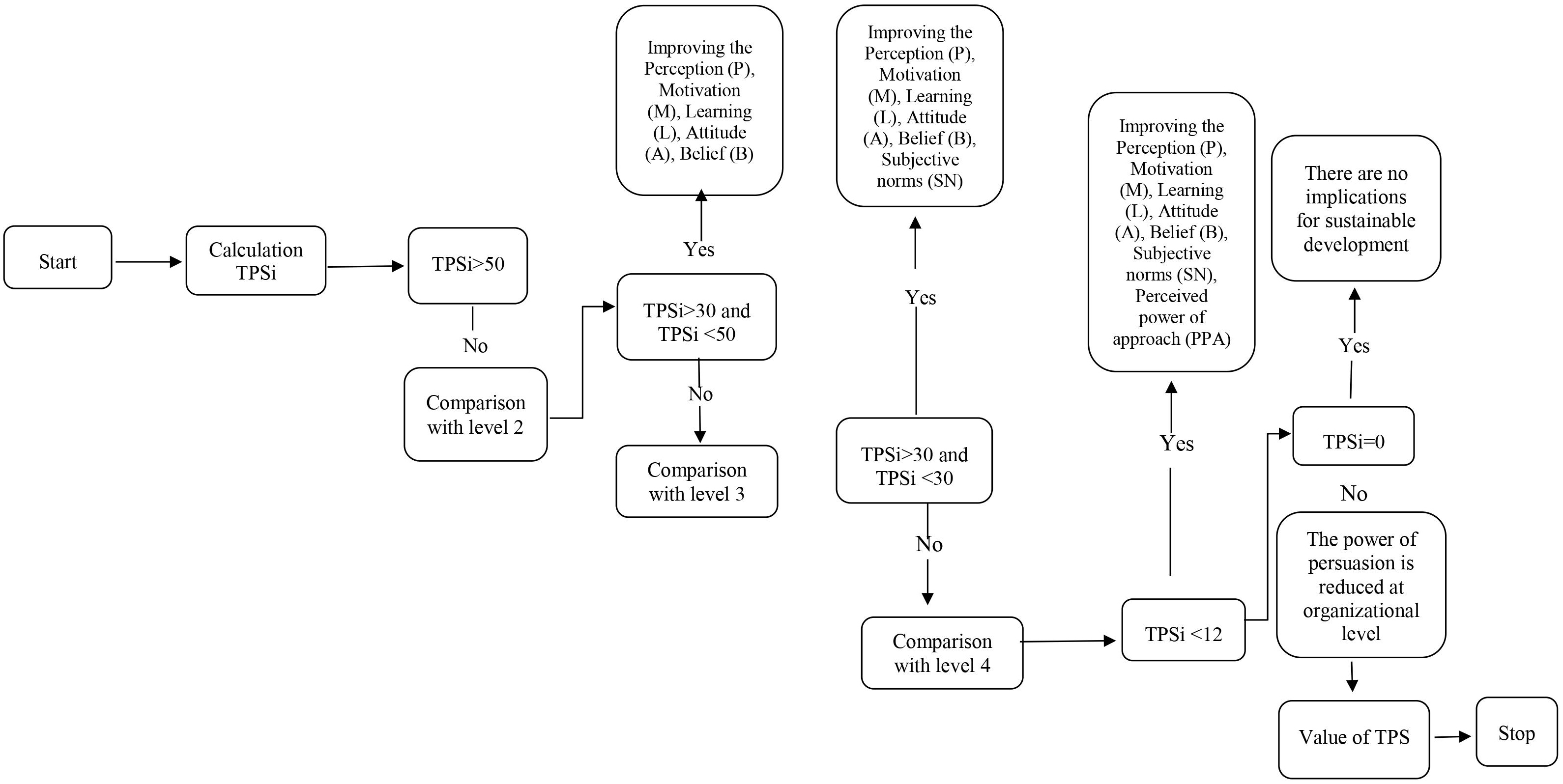
Figure 2. Simulating the improvement of psychosocial factors that contribute to organizational involvement in sustainable development.
Discussion and Conclusion
Following the research, an image is outlined on the PF that contribute to applying the principles of sustainability within the organization. The following discussions and future directions can be outlined. The research period was COVID-19, and the participants in the investigation stressed the importance of a strong motivation for adoption and involvement in further efforts. The COVID-19 period emphasized the need for a positive attitude to identifying new organizational opportunities. For the investigation, working groups were set up according to the organization’s level of innovation. The methods used in the present research, in-depth interviews, and the Delphi method were selected because they were considered effective methods for the research objectives. In-depth interviews provide concise, complex, and unambiguous results due to an expert who interviews each group.
Moreover, at the interviewed groups’ level, there were no deviations from the subject of tensions. These results were input for the Delphi method, with which experts in the field were able to generate a final report on PF involved in sustainable development. The Delphi method is a method that contributes to obtaining complex results in a short time with existing participants anywhere in the world.
In Romania, product and process innovations are numerous. Small and medium-sized organizations also have a high level of innovation. Simultaneously, the industry is involved in innovation, reaching a significant percentage. These working groups answered the 10 general questions, to which 5 personalized questions were added. The 20 experts outlined the PF that contribute to applying the principles of sustainability. Existing framework analyses were used. Following the identification, the four levels of importance were defined.
All experts have agreed on these levels. Level 1 includes perception (P), motivation (M), learning (L), attitude (A), belief (B), and BI. The second level comprises SN. The third level includes the PPA. The fourth level includes control of perceived behavior (CPB) and perception (P). Improving these factors contributes to improving organizational implications in SD. Stakeholders have an important role to play in applying innovative concepts. During the COVID-19 period, stakeholders showed some restraint, and certain negative attitudes were accentuated.
Correlating the level of importance of PF with the level of intensity of involvement in organizational sustainability contributes to identifying directions that need to be improved to increase the organization’s capacity to innovate and be involved in sustainability. This research covers certain gaps at the national level regarding a clear and objective identification of psychosocial factors.
The research’s future directions aimed at developing customized analysis frameworks for each field of activity. These frameworks will be correlated with important levels of sustainability.
Data Availability Statement
The raw data supporting the conclusions of this article will be made available by the authors, without undue reservation.
Author Contributions
All authors listed have made a substantial, direct and intellectual contribution to the work, and approved it for publication.
Funding
This research was funded by the Major Program of the National Social Science Fund of China, grant number 15ZDB169.
Conflict of Interest
The authors declare that the research was conducted in the absence of any commercial or financial relationships that could be construed as a potential conflict of interest.
References
Abdullah, M. I., Ashraf, S., and Sarfraz, M. (2017). The organizational identification perspective of CSR on creative performance: The moderating role of creative self-efficacy. Sustainability 9:2125. doi: 10.3390/su9112125
Abdullah, M. I., Sarfraz, M., Qun, W., and Javaid, N. (2018). Drivers of green supply chain management. LogForum 14, 437–447. doi: 10.17270/J.LOG.2018.297
Abidin, N. Z. (2009). Sustainable construction in Malaysia–Developers’ awareness. World Acad. Sci. Eng. Technol. 53, 807–814.
Adams, A., and Cox, A. L. (2016). “Questionnaires, in-depth interviews and focus groups,” in Research Methods for Human–Computer Interaction, eds J. Lazar, J. H. Feng, and H. Hochheiser (Hoboken, NJ: Wiley), doi: 10.1017/cbo9780511814570.003
Adloff, F. (2019). “Sustainability,” in Critical Terms in Futures Studies, ed. H. Paul (Cham: Palgrave Macmillan), 291–297. doi: 10.1007/978-3-030-28987-4_45
Ajzen, I. (1985). “From intentions to actions: a theory of planned behavior,” in Action Control, (Berlin: Springer), 11–39. doi: 10.1007/978-3-642-69746-3_2
Ajzen, I. (1991). The theory of planned behavior. Organ. Behav. Hum. Dec. Process. 50, 179–211. doi: 10.1016/0749-5978(91)90020-T
Ajzen, I. (2012). “The theory of planned behavior,” in Handbook of Theories of Social Psychology, Vol. 1, eds P. A. M. Van Lange, A. W. Kruglanski, and E. T. Higgins (Thousand Oaks, CA: SAGE), doi: 10.4135/9781446249215.n22
Al-Mulali, U., and Ozturk, I. (2015). The effect of energy consumption, urbanization, trade openness, industrial output, and the political stability on the environmental degradation in the MENA (Middle East and North African) region. Energy 84, 382–389. doi: 10.1016/j.energy.2015.03.004
Anderton, K. (2010). Two billion cars: driving towards sustainability. Transport Rev. 30, 675–676. doi: 10.1080/01441640903187092
Apergis, N., and Ozturk, I. (2015). Testing environmental Kuznets curve hypothesis in Asian countries. Ecol. Indic. 52, 16–22. doi: 10.1016/j.ecolind.2014.11.026
Arfini, F., Antonioli, F., Donati, M., Gorton, M., Mancini, M. C., Tocco, B., et al. (2019). “Conceptual framework,” in Sustainability of European Food Quality Schemes: Multi-Performance, Structure, and Governance of PDO, PGI, and Organic Agri-Food Systems, eds F. Arfini and V. Bellassen (Berlin: Springer), doi: 10.1007/978-3-030-27508-2_1
Barquet, A. P., Seidel, J., Seliger, G., and Kohl, H. (2016). Sustainability factors for PSS business models. Procedia Cirp. 47, 436–441. doi: 10.1016/j.procir.2016.03.021
Blevis, E. (2007). “Sustainable interaction design: invention and disposal, renewal and reuse,” in Proceedings of the SIGCHI Conference on Human Factors in Computing Systems, ed. M. Jones (New York, NY: Association for Computing Machinery), 503–512. doi: 10.1145/1240624.1240705
Bocken, N. M., Short, S. W., Rana, P., and Evans, S. (2014). A literature and practice review to develop sustainable business model archetypes. J. Cleaner Prod. 65, 42–56. doi: 10.1016/j.jclepro.2013.11.039
Botterill, D., and Platenkamp, V. (2014). “Delphi method,” in Key Concepts in Tourism Research, eds D. Botterill and V. Platenkamp (Thousand Oaks, CA: SAGE), doi: 10.4135/9781473914674.n11
Campbell, J. L., Quincy, C., Osserman, J., and Pedersen, O. K. (2013). Coding in-depth semistructured interviews: problems of unitization and intercoder reliability and agreement. Sociol. Methods Res. 42, 294–320. doi: 10.1177/0049124113500475
Chalmers, J., and Armour, M. (2019). “The delphi technique,” in Handbook of Research Methods in Health Social Sciences, ed. P. Liamputtong (Berlin: Springer), doi: 10.1007/978-981-10-5251-4_99
Choong, C. G., and McKay, A. (2014). Sustainability in the Malaysian palm oil industry. J. Cleaner Prod. 85, 258–264. doi: 10.1016/j.jclepro.2013.12.009
Cioca, L. I., Ivascu, L., Rada, E. C., Torretta, V., and Ionescu, G. (2015). Sustainable development and technological impact on CO2 reducing conditions in Romania. Sustainability 7, 1637–1650. doi: 10.3390/su7021637
Cruijssen, F. (2020). “Synthesis,” in International Series in Operations Research and Management Science, (Cham: Springer), doi: 10.1007/978-3-030-57093-4_9
Dincer, I., and Acar, C. (2017). Innovation in hydrogen production. Int. J. Hydrogen Energy 42, 14843–14864. doi: 10.1016/j.ijhydene.2017.04.107
Eccles, R. G., Ioannou, I., and Serafeim, G. (2014). The impact of corporate sustainability on organizational processes and performance. Manag. Sci. 60, 2835–2857. doi: 10.1287/mnsc.2014.1984
Erdmann Hilty, L., Goodman, J., and Arnfalk, P. L. (2004). The Future Impact of ICTs on Environmental Sustainability. Spruce Grove, AB: IPTS Publications.
Farhani, S., and Ozturk, I. (2015). Causal relationship between CO 2 emissions, real GDP, energy consumption, financial development, trade openness, and urbanization in Tunisia. Environ. Sci. Pollut. Res. 22, 15663–15676. doi: 10.1007/s11356-015-4767-1
Fishbein, M., and Ajzen, I. (1975). “Strategies of change: active participation,” in Belief, Attitude, Intention, and Behavior: An Introduction to Theory and Research, (Reading, MA: Addison-Wesley).
Fishbein, M., and Ajzen, I. (2010). “The reasoned action approach,” in Predicting and Changing Behavior, (Hove: Psychology Press).
Ford, S., and Despeisse, M. (2016). Additive manufacturing and sustainability: an exploratory study of the advantages and challenges. J. Cleaner Prod. 137, 1573–1587. doi: 10.1016/j.jclepro.2016.04.150
Gordon, T., and Pease, A. (2006). RT Delphi: an efficient,“round-less” almost real time Delphi method. Technol. Forecast. Soc. Change 73, 321–333. doi: 10.1016/j.techfore.2005.09.005
Guest, G., Bunce, A., and Johnson, L. (2006). How many interviews are enough? An experiment with data saturation and variability. Field Methods 18, 59–82. doi: 10.1177/1525822x05279903
Hale, J. L., Householder, B. J., and Greene, K. L. (2002). The theory of reasoned action. Pers. Handb. Dev. Theor. Pract. 14, 259–286. doi: 10.4135/9781412976046.n14
Hesselbach, J., and Herrmann, C. (2011). “Glocalized solutions for sustainability in manufacturing,” in Proceedings of the 18th CIRP International Conference on Life Cycle Engineering, Technische Universität Braunschweig, Braunschweig, Germany, May 2nd-4th, 2011, (Berlin: Springer Science and Business Media), doi: 10.1007/978-3-642-19692-8
Hill, R. J., Fishbein, M., and Ajzen, I. (1977). Belief, attitude, intention and behavior: an introduction to theory and research. Contemp. Sociol. 6:244. doi: 10.2307/2065853
Honda (2020). Honda Sustainability Report 2020. Climate Change 2013 – The Physical Science Basis. Torrance, CA: Honda.
Horn, C. M., Gilmore, M. P., and Endress, B. A. (2012). Ecological and socio-economic factors influencing aguaje (Mauritia flexuosa) resource management in two indigenous communities in the Peruvian Amazon. Forest Ecol. Manag. 267, 93–103. doi: 10.1016/j.foreco.2011.11.040
Humphrey-Murto, S., Wood, T. J., Gonsalves, C., Mascioli, K., and Varpio, L. (2020). The delphi method. Acad. Med. 95:168. doi: 10.1097/ACM.0000000000002887
International Union for Conservation of Nature (IUCN) (2020). Business and Biodiversity Report, Available online at: https://www.iucn.org/theme/business-and-biodiversity
Ivascu, L. (2020). Measuring the implications of sustainable manufacturing in the context of industry 4.0. Processes 8:585. doi: 10.3390/pr8050585
Jayal, A. D., Badurdeen, F., Dillon, O. W. Jr., and Jawahir, I. S. (2010). Sustainable manufacturing: modeling and optimization challenges at the product, process and system levels. CIRP J. Manufact. Sci. Technol. 2, 144–152. doi: 10.1016/j.cirpj.2010.03.006
Kamali, M., and Hewage, K. (2017). Development of performance criteria for sustainability evaluation of modular versus conventional construction methods. J. Cleaner Prod. 142, 3592–3606. doi: 10.1016/j.jclepro.2016.10.108
Kayikci, Y. (2018). Sustainability impact of digitization in logistics. Procedia Manufact. 21, 782–789. doi: 10.1016/j.promfg.2018.02.184
Kveselis, V., Dzenajavičienė, E. F., and Masaitis, S. (2017). Analysis of energy development sustainability: the example of the Lithuanian district heating sector. Energy Policy 100, 227–236. doi: 10.1016/j.enpol.2016.10.019
Labuschagne, C., Brent, A. C., and Van Erck, R. P. (2005). Assessing the sustainability performances of industries. J. Cleaner Prod. 13, 373–385. doi: 10.1016/j.jclepro.2003.10.007
Lada, S., Harvey Tanakinjal, G., and Amin, H. (2009). Predicting intention to choose halal products using theory of reasoned action. Int. J. Islamic Middle East. Finan. Manag. 2, 66–76. doi: 10.1108/17538390910946276
Lal, R. (2016). “Environmental sustainability,” in Climate Change and Multi-Dimensional Sustainability in African Agriculture: Climate Change and Sustainability in Agriculture, eds R. Lal, D. Kraybill, D. Hansen, B. Singh, T. Mosogoya, and L. Eik (Cham: Springer), doi: 10.1007/978-3-319-41238-2_1
Lim, S. S., Allen, K., Bhutta, Z. A., Dandona, L., Forouzanfar, M. H., Fullman, N., et al. (2016). Measuring the health-related sustainable development goals in 188 countries: a baseline analysis from the Global Burden of Disease Study 2015. Lancet 388, 1813–1850. doi: 10.1016/S0140-6736(16)31467-2
Linnenluecke, M. K., and Griffiths, A. (2010). Corporate sustainability and organizational culture. J. World Bus. 45, 357–366. doi: 10.1016/j.jwb.2009.08.006
Linstone, and Turoff, M. (1976). The Delphi Method: Techniques and Applications. Reading, MA: Addison-Wisley, doi: 10.2307/1268751
Liu, J., Mooney, H., Hull, V., Davis, S. J., Gaskell, J., Hertel, T., et al. (2015). Systems integration for global sustainability. Science 347:6225. doi: 10.1126/science.1258832
Longhurst, R. (2009). “Interviews: in-depth, semi-structured,” in International Encyclopedia of Human Geography, (Elsevier: Amsterdam), 580–584. doi: 10.1016/B978-008044910-4.00458-2
Ma, T., Østergaard, P. A., Lund, H., Yang, H., and Lu, L. (2014). An energy system model for Hong Kong in 2020. Energy 68, 301–310. doi: 10.1016/j.energy.2014.02.096
Madden, T. J., Ellen, P. S., and Ajzen, I. (1992). A comparison of the theory of planned behavior and the theory of reasoned action. Pers. Soc. Psychol. Bull. 18, 3–9. doi: 10.1177/0146167292181001
Mani, M., Lyons, K. W., and Gupta, S. K. (2014). Sustainability characterization for additive manufacturing. J. Res. Natl. Inst. Stand. Technol. 119:419. doi: 10.6028/jres.119.016
Marhani, M. A., Jaapar, A., and Bari, N. A. A. (2012). Lean Construction: towards enhancing sustainable construction in Malaysia. Proc. Soc. Behav. Sci. 68, 87–98. doi: 10.1016/j.sbspro.2012.12.209
Molavi, J., and Barral, D. L. (2016). A construction procurement method to achieve sustainability in modular construction. Proc. Eng. 145, 1362–1369. doi: 10.1016/j.proeng.2016.04.201
Naik, T. R. (2008). Sustainability of concrete construction. Pract. Period. Struct. Des. Construct. 13, 98–103. doi: 10.1061/(asce)1084-0680200813:2(98)
National Institute of Statistics (2020). Statistical Databases – TEMPO-Online Time Series, Bucharest, Romania. Available online at: http://statistici.insse.ro:8077/tempo-online/
Noone, J., Knox, A., O’Loughlin, K., McNamara, M., Bohle, P., and Mackey, M. (2018). An analysis of factors associated with older workers’ employment participation and preferences in Australia. Front. Psychol. 9:2524. doi: 10.3389/fpsyg.2018.02524
Oparaocha, S., and Dutta, S. (2011). Gender and energy for sustainable development. Curr. Opin. Environ. Sustain. 3, 265–271. doi: 10.1016/j.cosust.2011.07.003
Ozturk, I. (2017). The dynamic relationship between agricultural sustainability and food-energy-water poverty in a panel of selected Sub-Saharan African Countries. Energy Policy 107, 289–299. doi: 10.1016/j.enpol.2017.04.048
Pislaru, M., Herghiligiu, I. V., and Robu, I. B. (2019). Corporate sustainable performance assessment based on fuzzy logic. J. Cleaner Prod. 223, 998–1013. doi: 10.1016/j.jclepro.2019.03.130
Pradhan, P., Costa, L., Rybski, D., Lucht, W., and Kropp, J. P. (2017). A systematic study of sustainable development goal (SDG) interactions. Earths Future 5, 1169–1179. doi: 10.1002/2017EF000632
Richardson, B. C. (2005). Sustainable transport: analysis frameworks. J. Transp. Geogr. 13, 29–39. doi: 10.1016/j.jtrangeo.2004.11.005
Rizzo, T. L., and Columna, L. (2020). “Theory of planned behavior,” in Routledge Handbook of Adapted Physical Education, eds J. A. Haegele, S. R. Hodge, and D. R. Shapiro (London: Routledge), doi: 10.4324/9780429052675-25
Rossmann, C. (2011). Theory of Reasoned Action – Theory of Planned Behavior. Baden-Baden: Nomos, doi: 10.5771/9783845260341
Sadiq, M. W., Hameed, J., Abdullah, M. I., and Noman, S. M. (2020). Service innovations in social media and blogging websites: enhancing customer’s psychological engagement towards online environment friendly products. Revist. Argent. Clín. Psicol. 29:677.
Sarfraz, M., Qun, W., Abdullah, M. I., and Alvi, A. T. (2018a). Employees’ perception of corporate social responsibility impact on employee outcomes: mediating role of organizational justice for small and medium enterprises (SMEs). Sustainability 10:2429. doi: 10.3390/su10072429
Sarfraz, M., Qun, W., Hui, L., and Abdullah, M. I. (2018b). Environmental risk management strategies and the moderating role of corporate social responsibility in project financing decisions. Sustainability 10:2771. doi: 10.3390/su10082771
Schroeder, P., Anggraeni, K., and Weber, U. (2019). The relevance of circular economy practices to the sustainable development goals. J. Ind. Ecol. 23, 77–95. doi: 10.1111/jiec.12732
Sinclair, P., Cohen, B., Hansen, Y., Basson, L., and Clift, R. (2015). Stakeholder engagement within the sustainability assessment of bioenergy: case studies in heat, power and perennial and annual crops from the UK. Biomass Bioenergy 73, 11–22. doi: 10.1016/j.biombioe.2014.11.017
Smith, A., Voß, J. P., and Grin, J. (2010). Innovation studies and sustainability transitions: the allure of the multi-level perspective and its challenges. Res. Policy 39, 435–448. doi: 10.1016/j.respol.2010.01.023
Steg, L., and Gifford, R. (2005). Sustainable transportation and quality of life. J. Transp. Geogr. 13, 59–69. doi: 10.1016/j.jtrangeo.2004.11.003
Strathern, A., and Stewart, P. J. (2018). “What is sustainable?,” in Routledge Handbook of the History of Sustainability, ed. J. L. Caradonna (London: Routledge), doi: 10.4324/9781315543017-3
Tainter, J. A. (2011). Energy, complexity, and sustainability: a historical perspective. Environ. Innov. Soc. Trans. 1, 89–95. doi: 10.1016/j.eist.2010.12.001
Trafimow, D. (2009). The theory of reasoned action: a case study of falsification in psychology. Theory Psychol. 19, 501–518. doi: 10.1177/0959354309336319
Yigitcanlar, T., and Dur, F. (2010). Developing a sustainability assessment model: the sustainable infrastructure, land-use, environment and transport model. Sustainability 2, 321–340. doi: 10.3390/su2010321
Yılmaz, M., and Bakı, A. (2015). Sustainability in construction sector. Proc. Soc. Behav. Sci. 195, 2253–2262. doi: 10.1016/j.sbspro.2015.06.312
Appendix 1
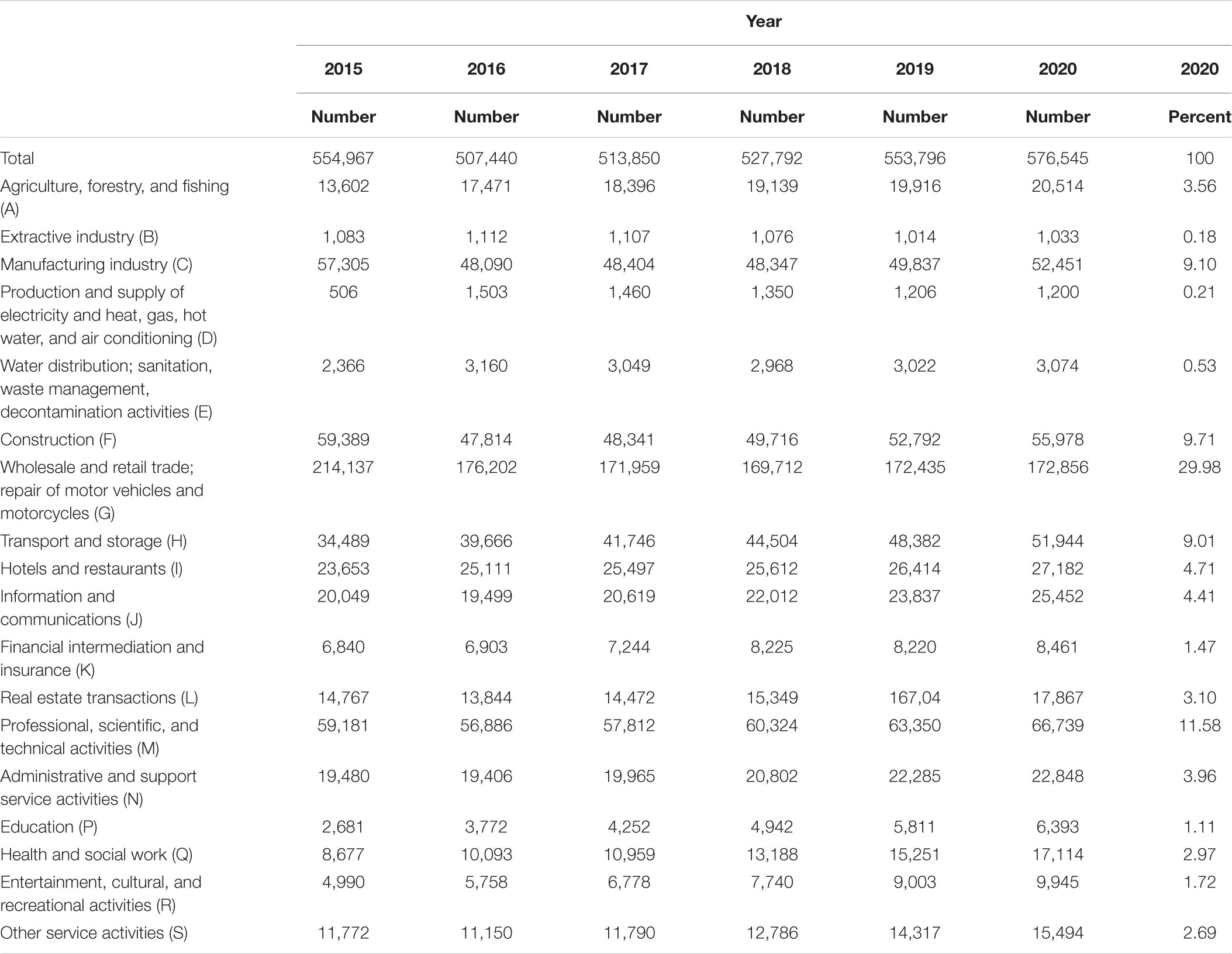
Table A1. Active enterprises, by activities of the national economy (National Institute of Statistics, 2020).
Keywords: sustainability, innovation, shareholder, theory of planned behavior, motivation, attitude, behavior, COVID-19
Citation: Dragan F, Luo C, Ivascu L and Ali M (2021) Assessing the Importance of Psychosocial Factors Associated With Sustainable Organizational Development During COVID-19. Front. Psychol. 12:647435. doi: 10.3389/fpsyg.2021.647435
Received: 29 December 2020; Accepted: 25 January 2021;
Published: 11 March 2021.
Edited by:
Ilhan Ozturk, Çağ University, TurkeyReviewed by:
Mian Sajid Nazir, Université de Montréal, CanadaCristin Bigan, Ecological University of Bucharest, Romania
Copyright © 2021 Dragan, Luo, Ivascu and Ali. This is an open-access article distributed under the terms of the Creative Commons Attribution License (CC BY). The use, distribution or reproduction in other forums is permitted, provided the original author(s) and the copyright owner(s) are credited and that the original publication in this journal is cited, in accordance with accepted academic practice. No use, distribution or reproduction is permitted which does not comply with these terms.
*Correspondence: Chaoping Luo, Y2hhb3BpbmdAc3d1LmVkdS5jbg==; Larisa Ivascu, bGFyaXNhLml2YXNjdUB1cHQucm8=
 Florin Dragan1
Florin Dragan1 Chaoping Luo
Chaoping Luo Larisa Ivascu
Larisa Ivascu